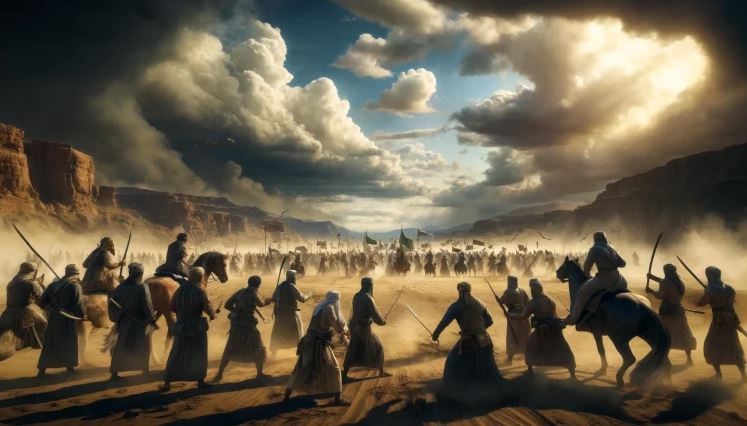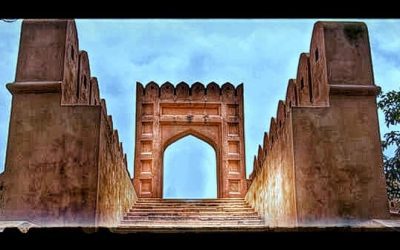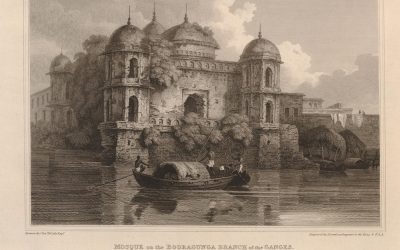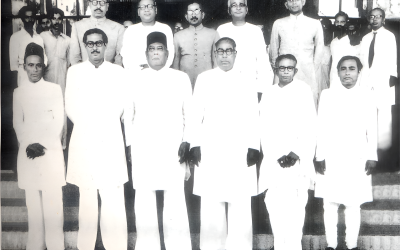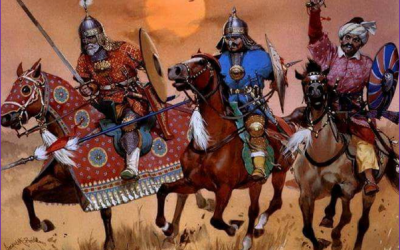Irfan Amin Patwary, Jahangirnagar University, Bangladesh
The early history of Islam is marked by several significant battles that not only shaped the trajectory of the Muslim community but also had a profound impact on the socio-political landscape of the Arabian Peninsula. Among these, the Battles of Badr, Uhud, and Khandaq stand out as critical events. Each battle, fought under the leadership of the Prophet Muhammad (PBUH), presented unique challenges and outcomes, contributing to the strategic and spiritual development of the early Muslim community. This comparative study aims to explore the causes, events, outcomes, and implications of these three pivotal battles.
The Battle of Badr (624 CE)
Background and Causes – The Battle of Badr was the first major military confrontation between the early Muslims of Medina and the Quraysh of Mecca. The immediate cause of the battle was the Muslims’ desire to intercept a caravan led by Abu Sufyan, a prominent Meccan leader, which was returning from Syria. The caravan was laden with goods and wealth that the Muslims believed rightfully belonged to them, as it was confiscated from them when they were forced to leave Mecca.
Forces and Strategy – The Muslims, numbering around 313, were significantly outnumbered by the Meccan army, which consisted of approximately 1,000 well-equipped soldiers. Despite their smaller numbers, the Muslims were motivated by a strong sense of faith and the promise of divine assistance. The battle took place near a well at Badr, strategically chosen by the Muslims to control the water supply and the surrounding terrain.
Key Events and Outcome – The Battle of Badr was marked by several key events, including the duel between Ali ibn Abi Talib, Hamza ibn Abdul Muttalib, and Ubaydah ibn al-Harith from the Muslim side, and three Quraysh champions. The Muslims emerged victorious in the duel, boosting their morale. The battle itself resulted in a decisive Muslim victory, with the Quraysh suffering heavy losses, including the deaths of several prominent leaders. The victory at Badr was seen as a divine endorsement of the Muslim cause and significantly bolstered the position of the Prophet Muhammad (PBUH) in Medina.
Significance – The Battle of Badr was a turning point for the early Muslim community. It demonstrated the effectiveness of their military strategy and the depth of their faith. The victory also led to increased support for the Prophet Muhammad (PBUH) among the tribes of Arabia. Furthermore, it dispelled the notion that the Muslims were a weak and insignificant group, instead establishing them as a formidable force.
The Battle of Uhud (625 CE)
Background and Causes – The Battle of Uhud took place a year after Badr and was a direct consequence of the Quraysh’s desire to avenge their defeat. The Quraysh, led by Abu Sufyan, assembled a larger army of about 3,000 men and marched towards Medina. The Muslims, aware of the impending attack, prepared to defend their city. The Prophet Muhammad (PBUH) initially suggested defending Medina from within, but after consulting with his companions, it was decided to meet the enemy at Mount Uhud, just outside the city.
Forces and Strategy – The Muslim army consisted of around 700 fighters, with a contingent of archers strategically positioned on a small hill to protect the rear. The Prophet Muhammad (PBUH) instructed the archers to hold their position regardless of the battle’s outcome. The strategy was to lure the Quraysh into the narrow pass and then encircle them.
Key Events and Outcome – Initially, the Muslims gained the upper hand, but a critical mistake by the archers, who abandoned their positions to collect spoils of war, turned the tide of the battle. The Quraysh cavalry, led by Khalid ibn al-Walid, took advantage of the exposed flank and launched a counterattack. The Muslims suffered heavy losses, including the death of Hamza, the Prophet’s uncle. The Prophet Muhammad (PBUH) was injured, and rumors of his death spread, causing further disarray among the Muslim ranks. Although the Quraysh were unable to capitalize on their victory by capturing Medina, the battle ended in a draw with both sides withdrawing.
Significance – The Battle of Uhud was a sobering experience for the Muslims. It taught them valuable lessons about obedience, discipline, and the consequences of disunity. The battle also revealed the resilience of the Muslim community, as they were able to regroup and maintain their position despite the setback. The defeat at Uhud was a test of faith, and the Muslims emerged more determined to continue their struggle.
The Battle of Khandaq (627 CE)
Background and Causes – The Battle of Khandaq, also known as the Battle of the Trench, was a result of a coalition of Arab tribes, led by the Quraysh and supported by Jewish tribes from Medina, seeking to destroy the Muslim community. The coalition army, numbering around 10,000, was the largest force the Muslims had faced. The Quraysh were determined to eliminate the threat posed by the Muslims once and for all.
Forces and Strategy – Faced with overwhelming odds, the Prophet Muhammad (PBUH) adopted a defensive strategy suggested by Salman al-Farsi, a Persian companion. The Muslims dug a deep trench around the northern part of Medina, where the city was most vulnerable to attack. The trench, a tactic unfamiliar to the Arabs, effectively neutralized the numerical superiority of the coalition forces.
Key Events and Outcome – The coalition forces were unable to breach the trench and were held at bay for several weeks. The siege took a toll on the coalition, leading to dwindling supplies and low morale. The harsh weather conditions further compounded their difficulties. Attempts to negotiate with the Jewish tribe of Banu Qurayza, who controlled the southern part of Medina, failed when the Prophet Muhammad (PBUH) successfully negotiated their neutrality. Eventually, internal discord and the onset of a severe storm forced the coalition to withdraw, resulting in a Muslim victory without direct combat.
Significance – The Battle of Khandaq marked a significant turning point in the Muslim-Quraysh conflict. It was a testament to the Prophet Muhammad’s (PBUH) strategic acumen and the importance of unity and perseverance. The failure of the Quraysh to defeat the Muslims despite overwhelming numbers demonstrated the strength and resilience of the Muslim community. The battle also led to the eventual downfall of the Quraysh’s influence in the region and paved the way for the conquest of Mecca.
Comparative Analysis
Military Strategy – The Battles of Badr, Uhud, and Khandaq each showcased different aspects of military strategy and leadership. Badr highlighted the importance of strategic location and morale, with the Muslims leveraging their knowledge of the terrain to their advantage. Uhud underscored the need for discipline and the dangers of disobedience, as a single misstep led to a near-disastrous defeat. Khandaq, on the other hand, exemplified the effectiveness of defensive warfare and the value of innovation in military tactics.
Leadership and Decision-Making – The Prophet Muhammad’s (PBUH) leadership was a constant across all three battles. His ability to inspire his followers, make strategic decisions, and adapt to changing circumstances was crucial to the outcomes of these battles. At Badr, his leadership rallied a small, under-equipped force to victory. At Uhud, despite the setback, he maintained control and prevented a complete rout. At Khandaq, his decision to adopt an unconventional defensive strategy demonstrated his willingness to innovate and adapt.
Impact on the Muslim Community – The impact of these battles on the Muslim community was profound. The victory at Badr solidified the Muslims’ position and increased their confidence in their cause. The setback at Uhud served as a reminder of the challenges they faced and the need for unity and discipline. Khandaq, with its successful defense against overwhelming odds, marked a turning point, leading to a shift in the balance of power in favor of the Muslims.
Psychological and Spiritual Dimensions – Each battle also had significant psychological and spiritual dimensions. Badr was seen as a divine intervention, reinforcing the belief that the Muslims were on the right path. The defeat at Uhud was a test of faith, emphasizing the importance of obedience to the Prophet (PBUH) and trust in God’s plan. Khandaq, with its relatively bloodless victory, highlighted the power of patience, perseverance, and divine support.
Long-Term Consequences – In the long term, these battles set the stage for the eventual expansion of Islam beyond the Arabian Peninsula. Badr demonstrated the viability of the Muslim community as a political and military force. Uhud, despite the losses, did not deter the Muslims but rather strengthened their resolve. Khandaq’s successful defense paved the way for the Treaty of Hudaybiyyah, which eventually led to the peaceful conquest of Mecca and the unification of the Arabian tribes under Islam.
The Battles of Badr, Uhud, and Khandaq were more than just military engagements; they were defining moments in the history of Islam. Each battle contributed to the development of the Muslim community, shaping its identity, strategies, and future trajectory. The comparative study of these battles reveals valuable lessons in leadership, strategy, and faith that continue to resonate in the collective memory of the Muslim world. From the initial victory at Badr to the hard-earned defense at Khandaq, these battles underscore the importance of resilience, unity, and unwavering belief in the face of adversity.
References
- Guillaume, Alfred. The Life of Muhammad: A Translation of Ibn Ishaq’s Sirat Rasul Allah. Oxford: Oxford University Press, 1955.
- Al-Mubarakpuri, Safi-ur-Rahman. The Sealed Nectar: Biography of the Noble Prophet. Riyadh: Darussalam, 1996.
- Ibn Kathir, The Battles of the Prophet. Translated by Wa’il ‘Abd al-Mut’al al-Dahab. Riyadh: Darussalam, 2006.
- Watt, W. Montgomery. Muhammad at Mecca. Oxford: Clarendon Press, 1953.
- Peters, F.E. Muhammad and the Origins of Islam. Albany: SUNY Press, 1994.

